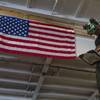When commercial designer Bauer Interiors hired the architectural firm of Landry and Lewis in Hattiesburg, Miss. to provide interior drawings of Horseshoe Casino's new riverboat, King of the Red, in Bossier City, La., they knew the draftsman would use computer-aided-design (CAD) graphics. Therefore, the company expected more than the usual hand-drawn renderings for the 275-ft.-long riverboat Horseshoe intended to replace its smaller Queen of the Red.
What they didn't count on getting were computer renderings so faithful to reality that when they are placed next to actual photographs of the finished interior, it's difficult to tell the difference.
"Using 3-D computer graphics software to create the interior renderings provided us and the client with numerous advantages you just don't get from the traditional hand-drawn color renderings," Bauer Interiors President Grace Bauer says. "It enabled us to make last-minute changes without having to tear out new walls; we could change colors or patterns or fixtures without repainting or re-papering."
The new state-of-the-art vessel for Horseshoe was to be one of the first of a new class of gaming riverboats - nearly twice the size of other competitors in the Bayou State. Unlike previous generations of gaming riverboats that were smaller, noisier and cramped with low ceilings, the new, bigger boat was to be designed for customer comfort. King of the Red would feature 62,000 sq. ft. of passenger space for some 2,500 guests in a luxurious environment. It was 30 ft. wider than its predecessor to allow passengers to circulate with unparalleled ease.
Young Chris Landry, son of one of the firm's partners and an associate at the firm off and on since he was 15, was assigned the job. Now in his early 20s, Landry had been tinkering with an advanced graphics software package, which was much more sophisticated than the AutoCAD program he had used in the past. The 3D Studio Max software by Autodesk, which makes AutoCAD, is used mostly by movie studios to create special effects for movies such as Toy Story. Its 3-D environment is also popular among car designers and architects.
Bauer provided Landry with the floor plans and told him to create a picture of what the riverboat's interior would resemble. The locations of objects such as the cashier, the change counter and where the slot machines would be placed were indicated, as well as traffic patterns, windows, doors, columns and walls.
Landry started with the floor plan and worked from the ground up. He built a 3-D wire frame and began filling in the materials.
"We provided them with samples of the materials to work with, we gave them everything from carpet, chair fabric and drapery samples to wallpaper and woodwork patterns," says Bauer Interior Designer Sarah Carmon. "We sent them catalog pictures of the light fixtures and photographs of the slot machines."
Landry scanned all the samples and patterns into his computer, sized them to the proper perspective and copied them over and over again to fill the riverboat. The carpet design soon covered the floor, fixtures hung from the ceiling and walls were painted and wallpaper applied.
What Bauer didn't have were pictures of the table games that would be used in the casino, so Landry turned to the Internet for images. Bauer supplied the dimensions and shapes of the gaming tables. Landry found a gaming supply warehouse and copied pictures of blackjack tables and other table games.
Once the texture maps were imported into the software, he could build the tables himself. The slot machine photo was copied 1,000 times and the machines carefully placed throughout the casino.
Some objects just plain had to be eyeballed, and couldn't be calculated. For instance the chair railings on the bar glass were created from scratch and then sized according to Landry's interpretation of the perspective.
"The Horseshoe project was the first photorealistic rendering I had done," Landry says. "The learning curve for this software takes awhile, and the longer I work on it, the more I can do, faster."
Gaming riverboats have special security requirements, and Bauer had to work with Landry to get the lighting accurate enough to reflect the light needed for monitoring cameras.
The amount of computer memory required for such a project was gargantuan. Landry totally devoted a 10 GB hard drive to the project.
"They had everything laid out how they wanted it and it was my job to show them what they visualized," Landry says. "The beauty of using 3-D graphics on a project like this is the ability to do a lot of tweaking as you progress. I would print out a low-res snapshot of a certain angle or piece of equipment and Bauer would check it."
Adding another dimension to what would otherwise be a 2-dimensional project enabled Bauer and the client to view angles they wouldn't see in a 2-dimensional rendering.
"From a 3-D perspective, you can see a top of a chimney that you wouldn't be able to see in 2-D," Landry says. "You can see if columns are too big or a roof is too high.
"There's only so much you can do with a 2-D elevation," he says. "It saves clients money when they can see it in the flesh, so to speak."
The finished product Bauer delivered to Horseshoe had 1.5 million 3-D surfaces. It took Landry's state-of-the-art Pentium computer three days to generate the image because the computer had to calculate each surface, then the light and texture on each surface and then apply the graphic.
"Using the 3-D software for our rendering gave us such a realistic view of what the riverboat's interior would resemble that we were able to make a lot of last-minute changes and tweaks well before the materials were ordered," Bauer says. "The end result is much more sophisticated and cost-efficient in the long run because we ended up having less to redo.
"It's the wave of the future," she says. "Besides being a wonderful tool, it increases our accuracy and efficiency."
Janet Plume handles marketing duties for Bauer Interiors, an interior design firm specializing in hospitality, healthcare and marine applications, based in New Orleans.
Sponsored Content
Lower carbon intensity fuels to support your operations

Subscribe for
Maritime Reporter E-News
Maritime Reporter E-News is the maritime industry's largest circulation and most authoritative ENews Service, delivered to your Email five times per week










